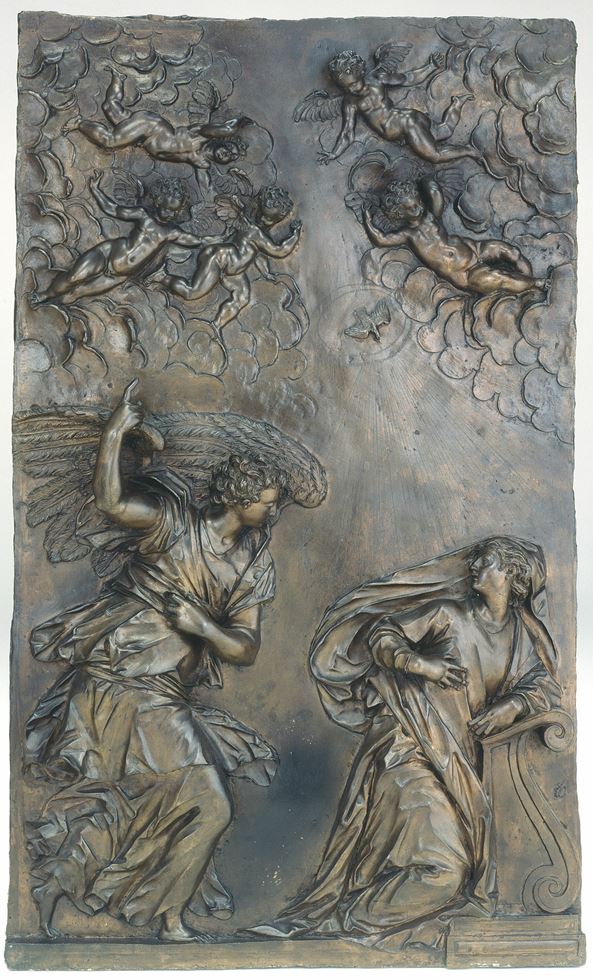Object of the Month: The Annunciation

Selected by Emerson Bowyer, Searle Associate Curator, Painting and Sculpture of Europe, Art Institute of Chicago.
Alessandro Vittoria (Italian, 1525-1608)
The Annunciation, c. 1583
Bronze, 97.8 × 61.6 cm (38 1/2 × 24 1/4 in.)
Art Institute of Chicago, Edward E. Ayer Endowment in memory of Charles L. Hutchinson, 1942.249
How can metal possibly contend with the extraordinary atmospheric and coloristic effects of 16th-century Venetian paintings? One would assume it to be an impossible task, given the hard, opaque, and seemingly monochromatic properties of bronze. But consider Alessandro Vittoria’s resplendent Annunciation, probably the most important bronze at the Art Institute of Chicago, and certainly among the most seductive Renaissance sculptures in America.
If ever the term painterly could be applied to bronze, this is it. Vittoria aspires to, and easily equals, the heights of paintings by his fellow Venetians Veronese, Titian, and Tintoretto. This relief altarpiece was clearly intended to compete with what was, at that time, more often a painted genre.
Here, intense colorism and lighting effects are the result of three-dimensionality rather than paint. One can imagine the artist working the model, pressing hot fingers against wax until it became warm and pliable. Pushing against it to create those marvelous clouds—like waves moving toward a shore. There’s a tidal force to them, an oceanic trajectory broken only by the downward, splitting path of the Holy Spirit. The varying levels of relief on the bronze’s reflective surface catch in the light, producing ever-changing images. And it’s not just a space of modeling but also of inscription (look at the etched rays of light emanating from the Holy Spirit, like electric currents flowing toward the miraculous event).
Our photograph doesn’t do the work justice. It represents merely a single, frozen moment. To stand before the relief, to move from side to side at different times of the day, is to witness a myriad of visual effects. It’s the seemingly ever-mutating surface properties of the sculpture that continue to astound me. This is bronze triumphant. Just imagine it viewed by candlelight, the figures appearing to shift and flicker, dancing to the movement of flame. The immediacy of the modeling, its very changeability in reflection and shadow, perfectly embodies the shock of the Annunciation.
Vittoria has managed to surpass the painted image. Where painting is static, bronze can achieve almost cinematic effects. Each time I view his relief, the experience is utterly fresh, and the scene unfolds anew.
Alessandro Vittoria (Italian, 1525-1608)
The Annunciation, c. 1583
Bronze, 97.8 × 61.6 cm (38 1/2 × 24 1/4 in.)
Art Institute of Chicago, Edward E. Ayer Endowment in memory of Charles L. Hutchinson, 1942.249
How can metal possibly contend with the extraordinary atmospheric and coloristic effects of 16th-century Venetian paintings? One would assume it to be an impossible task, given the hard, opaque, and seemingly monochromatic properties of bronze. But consider Alessandro Vittoria’s resplendent Annunciation, probably the most important bronze at the Art Institute of Chicago, and certainly among the most seductive Renaissance sculptures in America.
If ever the term painterly could be applied to bronze, this is it. Vittoria aspires to, and easily equals, the heights of paintings by his fellow Venetians Veronese, Titian, and Tintoretto. This relief altarpiece was clearly intended to compete with what was, at that time, more often a painted genre.
Here, intense colorism and lighting effects are the result of three-dimensionality rather than paint. One can imagine the artist working the model, pressing hot fingers against wax until it became warm and pliable. Pushing against it to create those marvelous clouds—like waves moving toward a shore. There’s a tidal force to them, an oceanic trajectory broken only by the downward, splitting path of the Holy Spirit. The varying levels of relief on the bronze’s reflective surface catch in the light, producing ever-changing images. And it’s not just a space of modeling but also of inscription (look at the etched rays of light emanating from the Holy Spirit, like electric currents flowing toward the miraculous event).
Our photograph doesn’t do the work justice. It represents merely a single, frozen moment. To stand before the relief, to move from side to side at different times of the day, is to witness a myriad of visual effects. It’s the seemingly ever-mutating surface properties of the sculpture that continue to astound me. This is bronze triumphant. Just imagine it viewed by candlelight, the figures appearing to shift and flicker, dancing to the movement of flame. The immediacy of the modeling, its very changeability in reflection and shadow, perfectly embodies the shock of the Annunciation.
Vittoria has managed to surpass the painted image. Where painting is static, bronze can achieve almost cinematic effects. Each time I view his relief, the experience is utterly fresh, and the scene unfolds anew.
Please check your email and activate your account
Something went wrong



